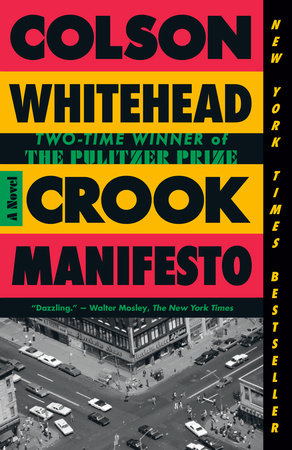Crook Manifesto Reader’s Guide
By Colson Whitehead


1. Crook Manifesto is set against the backdrop of 1970s New York City. Describe Carney’s Harlem. How do music, fashion, film, and politics combine to create the novel’s atmosphere and evoke life in the city during this period?
2. When we meet Carney, he is focused on his furniture store after stepping away from a career of fencing stolen goods. What initially motivates Carney to come out of his “criminal retirement” (page 7)? As the stakes become higher than anticipated, do you think this is the only factor that propels his return?
3. Carney rebuffs the idea that moving to Strivers’ Row, an affluent section of Harlem, was the reason that he turned his back on his crooked roots. In the novel, where do we see Carney navigate the dichotomy between crooked and straight, bent and narrow? Does he miss fencing? How does Carney attempt to reconcile his new life with his beckoning past?
4. Describe Carney and Elizabeth’s marriage. How does Carney view his wife, Elizabeth, and her ambitions? Do you think Elizabeth knows the full extent of his business? How does Carney’s criminal enterprise impact their relationship?
5. Carney and Munson both grew up playing the childhood game ringolevio. Compare Munson’s understanding of the game to Carney’s. Why is Munson reminded of ringolevio during his heists? How does the childhood game mirror his career as a cop? What difficult memories resurface for Carney when he remembers the game, and why does he worry about his son playing it?
6. How would you characterize the dynamic between Carney and Munson? Friendly and nostalgic? Manipulative and dangerous? A little bit of both? What past events impact their relationship in the present? Were you surprised that their partnership took the turn that it did?
What is Pepper’s connection to the Carney family? Why does he initially bristle at his “Uncle Pepper” nickname? As the novel continues, how does his relationship with Carney, Elizabeth, and their children develop?
7. On page 179, Pepper explains, “A man has a hierarchy of crime, of what is morally acceptable and what is not, a crook manifesto.” Imagine writing a crook manifesto for the novel’s characters such as Carney, Munson, Zippo, and Oakes. What would be in it? How would their ideas of what is morally acceptable compare with one another’s?
8. Pepper often returns to the Roscoe Pope joke “white man ain’t killed me yet” (page 186) during tough moments in his recovery. Where did you notice humor being used in the novel, and how did it impact your reading experience?
9. Corruption and discrimination in the entertainment industry are revealed through the production of Zippo’s Blaxploitation film. How is the movie funded? Why does Lucinda take the role, and how is her career impacted by racism and sexism in Hollywood? Who has creative control over the final cut of the film, and what does this mean for Zippo’s original vision?
10. Lucinda, Pepper, and Zippo are united by their roles in the production of Nefertiti T.N.T. as well as by a shared desire to leave parts of their past behind. What are these characters trying to escape from, and why do they want to leave it behind? How do they attempt to be free of their history? In the end, are any of them successful?
11. In the novel, Harlem is its own character with a history that develops alongside the central figures of the story. How does Crook Manifesto pay homage to a city where the only constant is change? How does each character negotiate the tumultuous and unpredictable churn of life in the city? What impact does urban renewal, housing segregation, and crime have on the landscape of the city and the lives of the people who reside within it?
12. In the novel, Carney is haunted by memories of the smell of kerosene on his father’s clothes. Who are the finishers, and what role do they play in the city’s urban renewal plans? Why is Carney obsessed with making them answer for their crimes? Are his motivations entirely selfless?
13. Who is Alexander Oakes? How do affluence and power contrast with under-the-table deals and shady schemes in his character? What kind of crook is he, and what does his character reveal about white-collar crime and corruption?
14. What was your reaction to the events in chapter seven of “The Finishers” and their aftermath? How does Carney come to understand the tragedy, and what do you think the future holds for him?
15. How does Carney’s criminal work influence his perception of the “straight” world? What does he think of the typically unquestioned aspects of the city such as street names and statues of prominent figures? If you were to look at your own city through his point of view, what would you uncover?
Just for joining you’ll get personalized recommendations on your dashboard daily and features only for members.
Find Out More Join Now Sign In